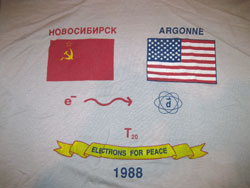
|
March 2010
|
|
|
The U.S. Department of Energy's Thomas Jefferson National Accelerator Facility
|
|
Site Prep Work to Begin on JLab's TEDF Project |
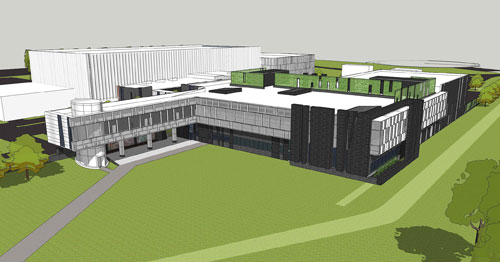 This architectural rendering shows an aerial perspective of the new Technology and Engineering Development Facility. Rendering by EwingCole.
The $73.2 million Technology and Engineering Development Facility project, or TEDF, has received Critical Decision 3a approval, or CD-3a, from the U.S. Department of Energy, clearing the way for an early start to pre-construction. Specifically, CD-3a allows for site preparation, the purchase of structural steel, relocation of the accelerator site entrance and other related pre-construction work. The CD-3a, also known as the Start Early Procurement Package, was received in late March. TEDF is designed to provide state-of-the-art facilities for research in the areas of nuclear physics, accelerator science, applied nuclear science and technology, and advanced superconducting radiofrequency instrumentation. Plans call for a 70,000-square-foot Technology and Engineering Development building, a 30,000-square-foot addition to the existing Test Lab building, and the modernization of the 96,000-square-foot Test Lab..... more |
|
|
JLab Names McKeown as Deputy Director for Science
|
Pennington to Lead Jefferson Lab Theory Center
|
Volunteers Needed for Saturday, May 1 Open House
|
||
|
|
||||
Below the Fold:
|
||||
Site Prep Work to Begin on JLab's TEDF Project |
 This architectural rendering shows an aerial perspective of the new Technology and Engineering Development Facility. Rendering by EwingCole.
The $73.2 million Technology and Engineering Development Facility project, or TEDF, has received Critical Decision 3a approval, or CD-3a, from the U.S. Department of Energy, clearing the way for an early start to pre-construction. Specifically, CD-3a allows for site preparation, the purchase of structural steel, relocation of the accelerator site entrance and other related pre-construction work. The CD-3a, also known as the Start Early Procurement Package, was received in late March. TEDF is designed to provide state-of-the-art facilities for research in the areas of nuclear physics, accelerator science, applied nuclear science and technology, and advanced superconducting radiofrequency instrumentation. Plans call for a 70,000-square-foot Technology and Engineering Development building, a 30,000-square-foot addition to the existing Test Lab building, and the modernization of the 96,000-square-foot Test Lab. The TEDF facilities will be designed to achieve Leadership in Energy and Efficiency Design (LEED) Gold Certification, according to Rusty Sprouse, manager of Jefferson Lab's Facilities Management and Logistics. To obtain a LEED certification, Jefferson Lab has minimized the amount of green space that will be used, thus limiting the number of trees that will be cut down. The A/C system will be 30 percent more efficient than industry-standard units. The work environment will be very nice and include natural light, views to the exterior and exterior landscaping. "We're working with the architects and interior designers to furnish the facility. The materials will have high recycled content and low volatile organic compounds," Sprouse has said. The Construction Manager/General Contractor for pre-construction services is Mortenson Construction, based in Minneapolis, Minn. The project has received $28 million for pre-construction in FY 2010. The laboratory is aiming to start actual construction of the facility by next fall and complete construction in 2012. For more information about the TEDF project, click here. |
Jefferson Lab Names McKeown as Deputy Director for Science |
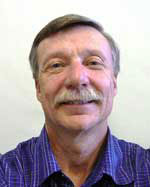 Robert D. McKeown
Jefferson Lab announced on March 25 the appointment of Robert D. McKeown, a leading nuclear physicist and professor at the California Institute of Technology, to the position of deputy director for science. "We are excited to have such a distinguished physicist and researcher as Bob agree to join our laboratory," said Jefferson Lab Director Hugh Montgomery. "His expertise and knowledge will be a tremendous resource for the laboratory, especially as we prepare for the 12 GeV research program and other future scientific ventures." In addition to serving as deputy director, McKeown also will become a Governor's Distinguished CEBAF Professor at The College of William and Mary. He will begin his duties at the laboratory on May 1. McKeown's research interests have included studies of weak interactions in nuclei, neutrino oscillations, parity-violating electron scattering, and the electromagnetic structure of nuclei and nucleons. He first became interested in experimental nuclear physics while an undergraduate student at Stony Brook University in Stony Brook, NY, where he received a B.S. in physics in 1974. He then continued his studies at Princeton University, where he received a Ph.D. in 1979. After one year as a scientist at Argonne National Laboratory, McKeown took a position as assistant professor of physics at the California Institute of Technology. He became an associate professor in 1986 and a professor in 1992. Over his career, McKeown's outstanding work has been recognized with many awards. He received a National Science Foundation Presidential Young Investigator award in 1984, was the Alexander M. Cruickshank Lecturer at the 1999 Gordon Conference on Nuclear Physics, and is a Fellow of the American Physical Society. He has served on the Nuclear Science Advisory Committee, the Physical Review C editorial board, and on advisory committees for Brookhaven National Laboratory, Fermilab and Jefferson Lab, where he served as chair of the JLab Users Group Board of Directors in 1990-91. Most recently, he received the 2009 Tom W. Bonner Prize in Nuclear Physics from the American Physical Society. The citation for the award recognized McKeown for "his pioneering work on studying nucleon structure using parity-violating electron scattering, in particular for the first measurement of the strange quark contribution to the electromagnetic structure of the proton." The Bonner Prize is presented annually in recognition of outstanding experimental research in nuclear physics |
Pennington to Lead Jefferson Lab Theory Center |
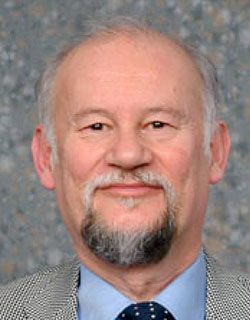 Michael R. Pennington
After an extensive search, Jefferson Lab has selected Michael R. Pennington, an internationally known physicist, as Associate Director for Theoretical and Computational Physics. Pennington is currently a Professor of Mathematical Sciences & Physics and Dean for Educational Outreach at the Durham University in England. Since 2007, Pennington also has served as a member of Jefferson Lab's Program Advisory Committee, a panel of world-leading physicists that reviews and selects experiments to be conducted at the laboratory. "All of us at the lab feel extremely fortunate and pleased that Mike has agreed to join our staff of outstanding physicists," said Hugh Montgomery, Jefferson Lab's director. "We believe that his experience, knowledge and standing within the international scientific community will make it possible for our Theory Center and the laboratory to remain in the forefront of nuclear physics research." Pennington, who will begin his duties at JLab on July 1, will succeed David Richards, who has been serving as the laboratory's interim head of theory since October 2009. "I have been an admirer of Jefferson Lab for some time, and it is a great honor for me to have been selected as the laboratory's next director of theory," Pennington said. "It's an especially exciting time to join the lab as it constructs its 12 GeV Upgrade and prepares for a future of potentially groundbreaking research." Pennington, whose research focus is in the theoretical and phenomenological study of the strong nuclear force, has more than 185 publications to his credit. In addition to his work for Jefferson Lab, he has served a variety of international science groups, including participation as a member of the CERN SPS Committee and as a member of the DAΦNE Physics Working Group in Frascati, Italy. In 2009, he was named an Outstanding Referee by the American Institute of Physics. |
Volunteers Needed for Saturday, May 1 Open House |
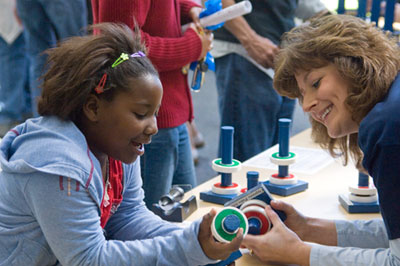 Kelly Webster, Accelerator Division, assists a young visitor with a magnet activity at the Science Education tables during the 2007 Open House.
Jefferson Lab's 2010 Open House, "A Celebration of Science," will take place on Saturday, May 1. Participation across the entire JLab community is what makes this event a success. The Public Affairs office is seeking lab staff, users and family members over age 13 to help with a variety of general event activities. General event volunteers are needed as bus stop attendants, bus monitors, greeters and walking path monitors. Sign up online now for the full day, 8:30 a.m. to 4 p.m., or half-day shifts. This web sign-up is only for volunteers helping with general event activities. Please direct general-event volunteer questions to Open House Volunteer Coordinator Tina Menefee, ext. 5490, cell 768-4030 or email menefee@jlab.org. She will confirm general event volunteer shifts and schedule your volunteer position. Volunteers leading tours or staffing displays or activities for specific programs or locations should sign up through their supervisor with their area's open house coordinator. Area Coordinators: All volunteers will receive a T-shirt to wear the day-of the event. General event volunteers should indicate their size when they sign up online. Area open house coordinators will take T-shirt sizes for the volunteers in their respective areas. Sizes are not guaranteed; and will be distributed on a first-come, first-served basis at the volunteer briefing. All volunteers must attend a mandatory volunteer briefing in the CEBAF Center Auditorium at one of the following times: Hourly employees will be paid, with advance approval from their supervisors. |
Hall D Tracking Detector on Track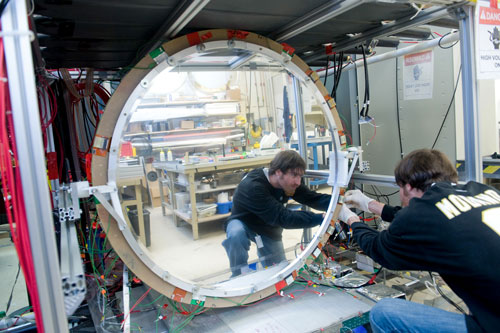 Although Jefferson Lab’s newest experimental hall, Hall D, is just starting to take shape, work is well underway on its sophisticated systems that will make it possible for scientists to gain a better understanding of how the invisible world of subatomic particles gives rise to our visible universe. In fact, a prototype package for one of these systems, the Forward Drift Chamber array, is already undergoing extensive testing at Jefferson Lab. The effort is being led by Daniel Carman, a Hall B staff scientist temporarily assigned to the project. The Forward Drift Chambers are a crucial part of the detector system that will be used in the first experiment planned for Hall D. The experiment, dubbed GlueX, is an exploration of the very glue that holds the particles of matter together. To learn about the subatomic glue, experimenters will produce and record the properties of subatomic particles called mesons. Scientists in the GlueX collaboration aim to produce ordinary mesons, as well as unusual varieties that have never before been observed. Mesons contain two quarks, the same building blocks found in protons and neutrons. These quarks are bound together by the strong force. In some of these mesons, called hybrid mesons, the strong-force glue between the meson's quarks is more prominent. "GlueX is designed to see a type of meson called a hybrid meson," says Carman. While hybrid mesons are fleeting, almost immediately breaking apart into other particles, they are also predictable, with each one leaving behind certain, known collections of ordinary particles. Identifying these sets of ordinary particles will allow scientists to gather information on the hybrid mesons they have produced. "There isn't anything exotic about the particles we will detect," Carman says. "They will be charged particles, including for instance, pions, protons and kaons." These charged particles will be monitored in the Forward Drift Chambers, which will be located along the core of the large GlueX detector, just behind the area where the mesons will be produced. The Forward Drift Chambers will consist of four separate packages of drift chambers spaced about 50 centimeters apart. 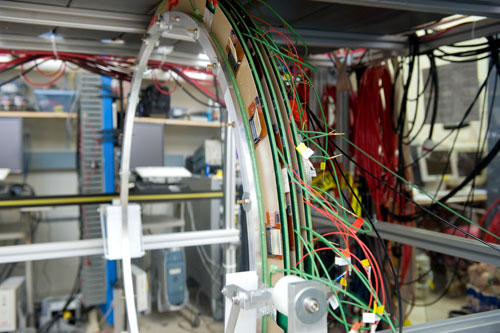 The full-scale Forward Drift Chamber prototype consists of three layers.
"Each package has six wire layers, with each layer sandwiched between two crossed cathode strip planes," Carman says. As a charged particle sails through a gas-filled drift chamber, it strips electrons from the atoms of the gas. The electrons "drift" to a wire, generating a signal that indicates the passage of the particle. A signal is also recorded through the cathodes. Combining these signals yields a three-dimensional point with an expected resolution of 0.2 millimeters. As the mesons are produced, they, and later, their specific set of daughter particles, will be subjected to a powerful magnetic field. Charged particles will react to the field by swirling through the detector in a corkscrew pattern. "So, as the particle spirals through the magnetic field, I can reconstruct its trajectory. And from its curvature, I can tell you what its momentum is," Carman explains. Combining this information with that gathered by the other GlueX detector systems will allow the collaborators to definitively identify the particles that will travel through the Hall D detector during the experiment. The Forward Drift Chambers mark the introduction of a new type of detector at Jefferson Lab. "What makes this design unique compared to the drift chambers that have been around for a very long time is that this thing is inside the area of the detector, where the particles are. So, we have to reduce its mass as much as possible," Carman says. Reducing the mass of the detectors, and therefore their weight, means that there is very little to obstruct the flight of the particles. Also, the design is challenging as these detectors are positioned in a high magnetic field, as high as 2.2 Tesla. To ensure the viability of this new combination of technologies at the laboratory, Carman and his team have constructed a full-scale prototype consisting of three layers, with each layer carefully tested as it was assembled. "Everything we've seen so far matches exactly what we expected. If we look at the signals, they have the right shape, they have the right amplitude, the right distribution. What we see in the cathodes matches what we expected from our simulations," he says. Currently, this full-scale Forward Drift Chamber package is undergoing testing in the Cosmic Ray Test Facility in the Experimental Equipment Lab. Testing began in January and will likely wrap up in June. Construction on other parts of the GlueX detector system is also in progress, including the solenoid magnet, barrel calorimeter, and lead glass calorimeter. If all goes well, the new experimental hall will be fully constructed and filled with a complement of new detector systems in just over four years' time. Further Reading: Hall D Detector for GlueX Gets Put to the Test: https://www.jlab.org/news/ontarget/jlab-newsletter-e-ontarget-october-2007#GluEx Staff Scientist Receives Citation as APS Fellow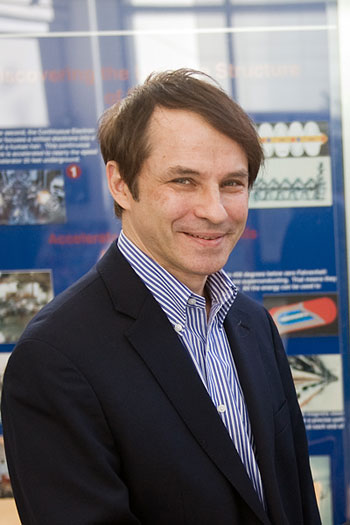 Bogdan Wojtsekhowski
Bogdan Wojtsekhowski, a staff scientist at Jefferson Lab for 15 years, recently received a citation as a Fellow of the American Physical Society for his outstanding contributions to instrumentation and his leadership role in studies of nucleon structure, particularly real Compton scattering on the proton and the neutron charge form factor. It is no understatement to say that Wojtsekhowski was born into physics. He was raised in Arzamas, Russia, where his father was an experimentalist who invented a system of dynamic armor to protect tanks from rockets. His father also nurtured his son's burgeoning interest in science, aligning it with his own interest in physics and seminal results, such as the nature of St. Elmo's fire and the structure of gas detonation. When Wojtsekhowski was four, his father moved to teach in Moscow and then transferred in 1958 to what was then a tiny hamlet of wooden cabins called Akademgorodok, which translates into "Academy Town." The government's plan turned this one-time sleepy village into the educational and scientific center of Siberia. By the time he went to the university in his home town, Wojtsekhowski noted, "Physics was a lifestyle" for him. While an undergraduate, he met Andrey Michailovich Budker, who was the founder of what was then the Institute of Nuclear Physics that now bears his name. Budker invited him to do his postgraduate work there in nuclear physics, which Budker believed was the physics of the future. "It was a very exciting time to be there," Wojtsekhowski recalled. By the late 1980s, Wojtsekhowski had traveled to the United States to work with American colleagues and had the chance to visit Jefferson Lab and Argonne. He later collaborated in Russia with Roy Holt on the T20 experiment (the shape of the deuteron defined the parameter T20 of the electron-deuteron scattering). The project, which they launched after encouragement from Larry Cardman and John Schiffer, was one of the first where American scientists were welcomed into Russia for their work. The result of that effort was published in the Physical Review Letters in 1990. It wasn’t all work, though. The group had T-shirts (designed by Ron Gilman, now at Rutgers University and Dave Baran, then a Northwestern University grad student working at ANL) that said "Electrons for Peace." This collaboration was completed in 2003. "It was a long saga with many moments of fun," Wojtsekhowski recalled. He praises the facilities at Jefferson Lab and his colleagues for what he believes has been a quadrupling of his productivity since coming here. "Our beam is so intense, we can do quite impressive experiments," he noted. "In Compton scattering we have improved the experiment productivity by one thousand times from what was possible before. This is groundbreaking work being done with good teamwork. Such experiments are like diamonds; they are forever. We have studied the neutron at a 10,000 times faster rate than I had imagined as a perfect goal in 1990. "Receiving the APS Fellowship," he noted, "is a confirmation of doing a useful job and encouragement to continue to make these efforts." Wojtsekhowski also has a deep interest in other areas of science, notably wind energy, and is also trained in mechanical engineering, which comes in handy when he is designing experiments. "My shelves shouldn't fall apart," he said with a smile, "and I can be sure that they won't. Physics is everywhere, all around us." "One of my next projects is an experiment in Hall A that will search for dark matter emitted by electrons in a process similar to light emission." Wojtsekhowski lives in Grafton with his wife, Leslie, who teaches Japanese and English as second languages. By Judi Tull JLab Researcher Wins New DOE Early Career GrantXiaochao Zheng, an assistant professor at the University of Virginia, has won a grant from the Department of Energy under the new Early Career Research Program, and she will use the federal funds to continue parity-violation and nucleon spin structure research at Jefferson Lab. The new program is designed to bolster the nation's scientific workforce by providing support to exceptional researchers during their early career years, when many scientists do their most formative work. Zheng says she will use the $786,000 award, which will be spread over five years, to help fund a postdoctoral researcher position and several student positions at UVA in support of Jefferson Lab research. In particular, the award will help Zheng and her collaborators complete data analysis on the recent Hall A experiment E08-011, a measurement of parity-violation in deep-inelastic scattering. "I'm looking forward to the analysis of this experiment," Zheng said. Once that analysis wraps up, she and her colleagues will shift their focus to another experiment, which will be a continuation of E08-011, but at the higher electron energies which will be possible with the 12 GeV facility. The new experiment, with much more exploration potential, was approved by the laboratory's Program Advisory Committee, a good indication that it will be scheduled to run following the completion of the 12 GeV Upgrade. The post-12 GeV run will require a new spectrometer package, dubbed the SoLID spectrometer. "I was hoping the postdoc could start the simulation on particular detector packages of this new spectrometer and then move on to testing it and making sure it suits the needs of Hall A," Zheng said. "But, we will first confirm where the collaboration needs help the most." She said she is honored to receive the early career award, is grateful to members of her collaboration and is cognizant of the broader impact this award has for nuclear physics research. "I am happy that this funding means that people are paying more attention to science. That's a good thing. I get a good boost to my work and confidence," Zheng added. The 69 Early Career awardees were announced in January by Energy Secretary Steven Chu. Up to $85 million in funding will be disbursed in this program under the American Recovery and Reinvestment Act. Zheng was selected from a pool of 1,750 university- and national laboratory-based applicants who received a Ph.D. in the past 10 years and whose research topics fall within the purview of the Office of Science's six major program offices. Selection was based on peer review by outside scientific experts. There were five nuclear physics awardees, including both experimental and theoretical researchers. A list of the awardees, their institutions and the titles of their research projects is available on the Early Career Research Program webpage. JSA Announces Winner of Postdoctoral Research Fellowship Award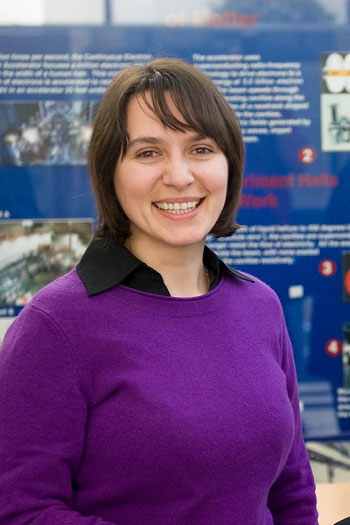 Simona Malace
In February, a postdoctoral scientist conducting research into the structure of the proton was awarded the 2010 JSA Postdoctoral Research Fellowship at Jefferson Lab. Simona Malace, from the University of South Carolina, was named the winner of the fellowship by the Jefferson Lab Users Group Board of Directors, which represents the roughly 1,300 scientists who conduct research at the laboratory. "I am very happy to receive this prize, and I would like to thank Dr. Wally Melnitchouk, Dr. Rolf Ent and Dr. Steffen Strauch for their support throughout my research," Malace said. Malace studies how quarks and gluons come together to build nucleons. To conduct the research, she and her colleagues use JLab's CEBAF accelerator to smash electrons into proton and deuteron targets. "Imagine sending a probe, at JLab this is an electron, to get information about the structure of the proton. Depending on the energy of the probe, you will see larger or smaller structure. Sometimes the quarks in a proton bind together to make more massive versions of the proton called resonances. These are the objects (a type of hadron) we want to study. Surprisingly, they behave the same way on average as the much smaller, individual, quarks do. This observation is called quark-hadron duality, and it is quite a mystery." Malace, in collaboration with fellow physicists Yonatan Kahn, Melnitchouk and Thia Keppel, is studying the differences in the results when looking at the proton and neutron resonances. The latter are very difficult to study, as there are no free neutrons in nature. However, such work is critical to understanding the mystery of duality as a truly fundamental property of hadron structure. The fellowship comes with a $10,000 research grant that Malace will use to defray the cost of a workshop to be scheduled this year addressing research into the underlying quark structure of the nucleon. The workshop is tentatively titled "Building knowledge of nucleon structure at large Bjorken x." Malace received her bachelor's and master's degrees from the University of Bucharest in Romania and her Ph.D. from Hampton University. Now, as a postdoc at the University of South Carolina, she has broadened her research interests to include another aspect of the proton's properties: How a proton that is bound inside a nucleus is different from a proton that is not. "We hope to scatter from a proton that is sitting inside a nucleus and then we want to compare it to the response of a free proton. The changes we see are due to the presence of the nuclear medium. The challenge is then to interpret these changes in terms of varied nuclear effects and possibly answer the question whether the proton structure is modified in the nuclear medium," she said. In making the award selection, the users board judged applicants on their records of accomplishment in physics, proposed uses of the research grant in a high-impact physics program and the likelihood of further accomplishments in the Jefferson Lab research program. "We had a slate of outstanding and deserving candidates contributing to the physics mission of Jefferson Lab. In fact, four candidates obtained first place votes, making our evaluation and choice of a winner truly difficult," said Zein-Eddine Meziani, board chairman and a professor at Temple University. "The winner has participated in a broad program of research, having performed analyses on two very different experiments. She is an integral member of her collaborations, is leading a new 12 GeV proposal and has a range of publications." This research fellowship is funded through a JSA Initiatives Fund grant. The JSA Initiatives Fund is a $500,000 program provided annually by Jefferson Sciences Associates, LLC. G-Zero Experiment Shows Results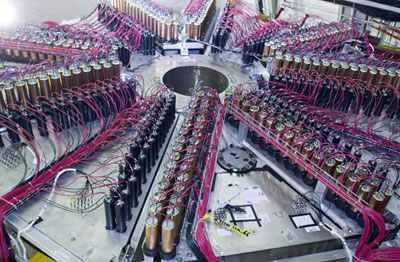 Pictured is a portion of the G-Zero custom detector system that was installed in JLab's Hall C. The experiment was designed to help researchers determine just how strange the ordinary matter around us can be.
The G-Zero collaboration of scientists have recently published the first of several of papers detailing its conclusions. In the G-Zero experiment, run at Jefferson Lab, researchers carried out a precisely tuned survey for ephemeral particles that appear briefly inside matter, helping to determine just how strange the ordinary stuff around us can be. Specifically, they wanted to measure the effect of strange particles in the proton, found deep inside the nucleus of every atom in our universe. Find out what the data revealed about strange quarks in the proton and much more at: https://www.jlab.org/news/stories/g-zero-experiment-proves-strange-quark-effects-not-big
Rui Li Named Outstanding Referee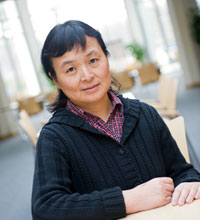 Rui Li
Rui Li, Accelerator Division, was recently named an Outstanding Referee for 2010 by the American Physical Society. The Outstanding Referees program was instituted in 2008 to recognize scientists who have been exceptionally helpful in assessing manuscripts for publication in the APS journals. The program annually recognizes about 150 of the roughly 45,000 currently active referees. Honorees are selected based on the quality, number and timeliness of their reports, according to the APS webpage. Like Fellowship in the APS, this is a lifetime award. For more information about the award and its recipients, visit: http://publish.aps.org/OutstandingReferees.
Time to Review Lab's Tornado AwarenessWhen it comes to tornadoes, there's really no such thing as a "tornado season." Tornadoes can strike anywhere, anytime, according to JLab Emergency Manager John Kelly. "While Virginia is not a hotbed for tornadoes, the Commonwealth of Virginia sets aside the third Tuesday in March for promoting statewide awareness of tornado dangers and how to prepare for and respond to an approaching storm," Kelly notes. And while Jefferson Lab wasn't involved in this year's event, Kelly says this is a good opportunity for reviewing the laboratory's tornado response procedures. To prepare for a tornado at Jefferson Lab: Know where the nearest weather-alert radio is located. Help ensure it is always turned on. If your area lacks a radio, inform your local safety warden. If you are a radio "custodian," this is a good time to replace the batteries. Know ahead of time where you would take cover if a tornado approaches JLab.
Response to a Warning: An isolated tornado gives little visual warning in a wooded area such as at JLab and the neighboring area. Advance warning will most likely be via the weather-alert radios distributed around the site and the Site-Wide Alert System. If an emergency notification is broadcasted that declares a tornado warning, take cover immediately.
* May be inaccessible because of beam operations More information on tornadoes and other weather emergencies may be found at: For additional information about tornado preparation and response at JLab, see Section 4.2 Tornadoes in the Severe Weather Procedures (Chapter 3510, Appendix T4) of the Environment, Safety & Health Manual at: http://www.jlab.org/ehs/ehsmanual/3510T4.htm. Admin Team Supports Physics Division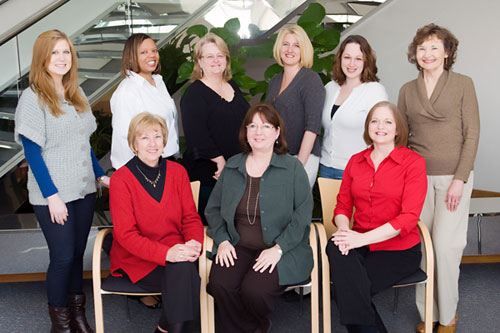 The Physics Admin group recently paused for a group photo. Pictured here are (front row, left to right) Marti Bennett, Jan Prater and Jodi Patient, and (back row, l. – r.) Jennifer Schatzel, Stephanie Tysor, Linda Ceraul, Rachel Harris, Lorelei Carlson and Lucy Collins. Not pictured: Erica Jones.
They're among the busiest people at Jefferson Lab. They are the group of 10 women who support the Physics Division, a task to which their leader, Janet Prater, says they're more than up to. "They rise to the occasion, day in, day out, and I'm always proud of them," she says. Their responsibilities are vast: they provide administrative support to the hall leaders; they're the ones who shepherd JLab's worldwide user community; they process travel arrangements; they coordinate workshops and manage budgets; and they staff the CEBAF Center Reception Desk. They get to know the individual personalities of the people they support. Flexibility is the key, and they do it all with a smile. Prater came to the laboratory as an administrative assistant in June 1991. After finishing her bachelor's degree in Organizational Psychology at Christopher Newport University, she got her first promotion and is now the division administrator for physics. Over the past 18 years, she has had a singular mission: "My focus with this group has always been to create a team that will join forces to get something done whenever it's needed," she says. "I don't think most people realize how much these women have to know and how much they do," Prater adds. "They make it look easy, but it's hard work. The truth is that they're just really, really good at it." Introducing the Physics Marti Bennett Each team member has an assigned back-up person, so no task is left undone in the face of sickness or vacation, which means their knowledge bases must overlap so they're ready to step in at a moment's notice. As the group that provides support to JLab's worldwide user community, they interact with hundreds of people each week and stand ready to help out whenever and wherever they're needed, which, in Prater's words, extends "from finding Band-Aids or a doctor, to coordinating workshops and planning the division's annual holiday party. They need to be thoroughly knowledgeable about every aspect of policy and procedures." Prater's job is to oversee all of it. "I troubleshoot all day long to make sure the division moves in a way that we help the lab's science program," she says. "Our support is total. My team learns what they need to know to do the job, do it well, and build good relationships across the lab. They work with everybody." As busy as the team is, they also find time to relax together. They eat together, exercise together, and most importantly, work really well together. By Judi Tull Education Seeks Projects for Summer Programs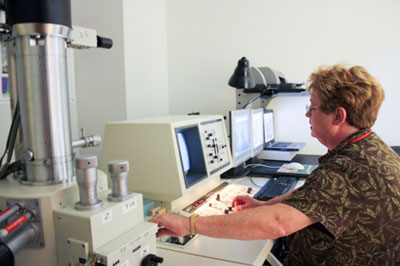 While participating in the ACTS program at Jefferson Lab, teacher Sandie Fusillo worked with Michael Kelley's group. Here she studies historical materials from the USS Monitor conservation project at the Mariners' Museum.
The Science Education staff is preparing for JLab's summer teachers' enrichment and high school internship programs, and they need the help of lab staff. Seven local/regional high school students will be at the laboratory from June 21 through July 30, participating in the High School Summer Honors Program. A mentor with an appropriate project is needed for each student. Twenty teachers will be here from July 5-30 as part of the Department of Energy's Academies Creating Teacher Scientists program. The Education staff is seeking mentors with hands-on projects where groups of two, three or four teachers could work about 40 hours each over the length of the program (about 10 hours per week per teacher). If you have a project or projects that would be good for a high-achieving high school student or for a small group of dedicated science teachers, send a short description of the project and what you'd like the student or teachers to do to Christine Wheeler, Science Education administrator, wheelerc@jlab.org. If you have questions call her at ext. 7560. She needs the ideas by June 1. The students and the teachers will be required to develop a poster about their project and present it during the poster session on the last day of their program. HSSHP allows high school students to participate in scientific or technical activities in directed projects for six weeks during the summer. Students chosen for these positions are interested in pursuing scientific and technical careers. The Academies Creating Teacher Scientists program engages educators as valued members of the scientific community and helps them progress as leaders of science, technology, engineering and mathematics (STEM) education. ACTS is a three-year program that provides STEM educators (Grades 5-12) with sustained, intensive professional development (experience and classroom) that uses the unmatched wealth of mentoring talent at DOE's national laboratories. Through this program, educators integrate the teaching of STEM disciplines with the practice of science, establish long-term relationships with their mentor scientists and teaching colleagues, and transfer their experiences in scientific research to the classroom. Participating teachers spend 4-8 weeks at one of the national labs for three consecutive summers. Order Your JLab Logo Gear Through Online StoreThe Jefferson Lab Activities Group now provides the JLab community with the opportunity to purchase a variety of merchandise with the JLab logo printed on it – from a link on the JAG webpage. Items may be ordered individually or in larger quantities. More than 30 different items are available to choose from, including: short and long-sleeved shirts, cardigans, T-shirts, sweatshirts, a variety of hats and a soft-sided bag. Clothing items are available in a variety of colors and sizes. The JLab logo can be embroidered in color on the items ordered. There is a two-week turn around on most orders. Routine orders are delivered by UPS ground shipment. Credit cards may be used to place orders on the webpage and over the phone. Personal checks also may be used for payment, but must be mailed and received or delivered to the vendor prior to the finished order being shipped. Check out the JLab On-line store at: http://www.jlab.org/intralab/committees/jag/store.html Milestones for February through mid-March 2010Hello Shahid Ahmed, Center for Advanced Studies of Accelerators Post Doctoral Fellow, Accelerator Division Goodbye James Graves, Physics Division These Milestone entries, listed alphabetically, are full-time, term, casual and student actions posted by Human Resources for February and the first half of March 2010. Jefferson Lab is currently seeking several qualified individuals for a wide range of engineering positions as well some scientific, administrative, student intern and information technology positions. More than 50 JLab employment opportunities are currently posted at: https://careers.peopleclick.com/careerscp/client_jeffersonlab/external/search.do For more information about employment at JLab, visit: http://www.jlab.org/div_dept/admin/HR/index.html. JLab Careers are also posted under the Popular Applications listing on JLab's internal Insight page. Longfellow Wins Virginia Middle School Science Bowl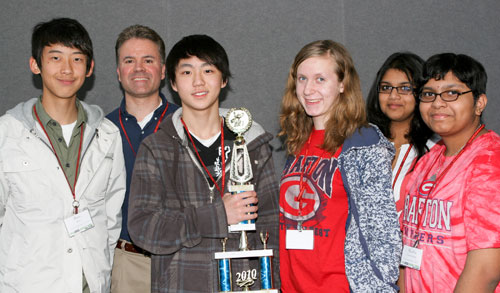 4th Place Grafton Team A took 4th place at the Virginia Regional Middle School Science Bowl. All of the students are 8th graders.
A crowd of nearly 200 parents, grandparents, siblings and neighbors turned out on March 6 to watch their students compete in the 2010 Virginia Regional Middle School Science Bowl held at Jefferson Lab. It was an exciting day as 17 teams faced off for the morning's round-robin matches. A sixth grade science club team, dubbed The Copernicus Crew, from Haycock Elementary School, Falls Church, routed its competition, winning all four of its round-robin matches. The Copernicus Crew made it to the third round of afternoon double-elimination playoffs before falling out of the competition. The Northern Virginia Homeschoolers, centered in Ashburn, fielded two teams this year: Mind Over Matter and Parallel Asymmetry. Mind Over Matter won its round-robin matches while Parallel Asymmetry fell to its competition. Grafton Team A, Yorktown, was the one Peninsula team still in the competition for afternoon playoff action. Grafton beat Chancellor Team B, Fredericksburg, in Round 2 before going head-to-head with the Great Bridge Green Team, Chesapeake. Regular play ended in a 54-54 tie, forcing the game into not just one, but an unprecedented four overtimes. Grafton moved ahead 82-70 in the fourth overtime to win the match. The Grafton team, coached by Carmen Fragapane, was then pitted against Mind Over Matter in round four. Drained from the intensity of the previous match, Grafton fell to the Ashburn team, 134-20; but the team made it far enough to garner the fourth place trophy at the end of the day. First Place went to Longfellow Middle School, Falls Church, and coached by Jim Bradford. The team won its final match with Salem Middle School, Virginia Beach, 106 to 16. For finishing first, the team took home a $750 check for its school, the regional banner that the team will carry to nationals, a team trophy and individual medals. The team also gets an expenses-paid trip to participate in the Department of Energy's Science Bowl Nationals – in Washington, D.C., April 29 to May 4. For finishing in second, the Salem Middle School team, coached by Darlene Sabol and Catherine Meechan, won a $500 check for its school and a team trophy. Third place, which included a $300 check and a team trophy, went to Mind Over Matter, coached by Vicki Ruiter and Marie-Jeanne Forbes. The teams that didn't advance to the afternoon double-elimination playoffs were invited to participate in the Stay All Day Contest – a series of three math, science and engineering challenges. Winning the Stay All Day Contest, with the best combined results from the three challenges, was Gildersleeve Middle School team, Newport News, coached by Timothy Criner. The team received a $300 check for its school and individual prizes. Eight of the coaches with teams at this year's event are former ACTS and JSAT teachers. The "JLab Science Activities for Teachers" and the Department of Energy's "Academies Creating Teacher Scientists" are two teacher development programs conducted at Jefferson Lab. JSAT meets on Wednesday evenings during the school year; and ACTS runs daily for six weeks during the summer. JSAT is funded through a JSA Initiatives Fund grant. The JSA Initiatives Fund is a $500,000 program provided annually by Jefferson Sciences Associates, LLC. Forty-five volunteer Jefferson Lab staff members, visiting scientists, family members and friends of JLab carried out the duties of moderators, timekeepers, scorekeepers, and scientific and rules judges for the event. The National Science Bowl tournament – sponsored by the DOE since 1991 – is an annual competition among teams of students. The teams face off in an intense question-and-answer format where contestants are quizzed on their knowledge in all science disciplines, including astronomy, biology, chemistry, earth science, general science, mathematics and physics. At the end of the day Virginia Regional Science Bowl Coordinator Jan Tyler, and Jefferson Lab's Science Education manager, applauded all the students, coaches, parents and volunteers for their part in making the event fun and a great success. She encourages the sixth and seventh grade students to start preparing for next year's Middle School Science Bowl and urges the eighth graders to come back for the High School Science Bowl. She encouraged all the students to stay involved in math, science and technology classes as they progress on to high school and college. The DOE Office of Science’s Workforce Development for Teachers and Scientists program, which manages the National Science Bowl, has a number of programs designed to help train the next generation of scientists and engineers with the goal of helping to maintain the nation’s scientific and technological leadership. DOE launched the National Science Bowl program for high-school and middle-school students to encourage students to choose an education in the sciences and engineering. Thomas Jefferson High School for Science & Technology Wins Virginia High School Science Bowl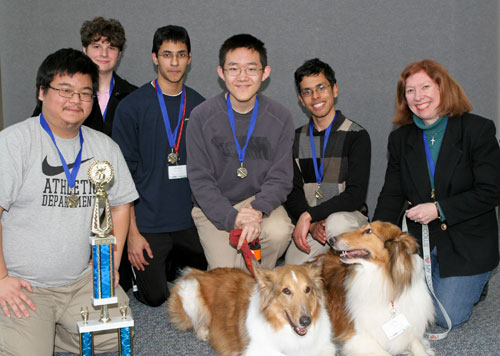 The team from Thomas Jefferson High School for Science and Technology, Alexandria, beat out 15 other schools to win the Virginia Regional High School Sciencs Bowl on Feb. 27. Left to righr are team members Daniel Li, Greyson Lewis, Akshar Wunnava, Hanwen Xu and Aaron Koenig and Coach Sharon Webb. Accompanying them are Virginia Science Bowl mascots Mario and Ollie.
The Thomas Jefferson High School for Science and Technology from Alexandria beat out St. Christopher's School from Richmond, 54-44, in the final round on Feb. 27 to win the Virginia Regional High School Science Bowl held at Jefferson Lab. St. Christopher's finished in second at the end of the intense, day-long academic competition, while Bishop Sullivan Catholic High School, from Virginia Beach, finished third. Gloucester High School, Gloucester, took fourth place. For finishing in first, the TJHSST team, coached by Sharon Webb, won an expense-paid trip to the U.S. Department of Energy Science Bowl Nationals to be held in Washington, D.C., April 29 to May 4. The team also took home a $750 check for its school, the regional banner that the team will carry to nationals, a team trophy and individual medals. The National Science Bowl tournament – sponsored by the U.S. Department of Energy since 1991 – is an annual competition among teams of students. The teams face off in an intense question-and-answer format where contestants are quizzed on their knowledge in all science disciplines, including astronomy, biology, chemistry, earth science, general science, mathematics and physics. The day is broken into two rounds: morning round-robin matches, followed by double-elimination matches in the afternoon. A match is two eight-minute halves with a two-minute break. Teams that didn't advance to the afternoon session were invited to compete in a design and engineering challenge dubbed the Stay All Day Contest. Teams were presented with three very different activities where they had to analyze problems, develop working prototypes with specific materials and make projections based on a model's performance. The team with the best combined results for the activities was Woodbridge Senior High School from Woodbridge and coached by Kathryn Voehl. They won individual prizes and received a check for $300 for their school. "These events champion an interest in science, technology, engineering and math among our nation's youth," notes Jan Tyler, Jefferson Lab's Science Education manager. DOE Seeks Applications for Nuclear-Related Science, Engineering Scholarships & FellowshipsThe Department of Energy recently issued two Requests for Applications for scholarships and fellowships as part of its efforts to recruit and train the next generation of nuclear scientists and engineers. The DOE's Nuclear Energy University Programs will provide approximately $5 million for scholarships and fellowships for students enrolled in two-year, four-year and graduate engineering and science programs related to nuclear energy at accredited U.S. universities and colleges. The Scholarship and Fellowship Program aims to attract the students to science and engineering disciplines related to nuclear energy, such as Nuclear Engineering, Mechanical Engineering, Electrical Engineering, Chemistry, Health Physics, Nuclear Materials Science, Radiochemistry, Applied Nuclear Physics, and Nuclear Policy at universities and colleges located in the U.S. Two-year programs that lead to a certificate or minor are also included, such as Nuclear Power Technology, Nuclear Maintenance Technology, Nuclear Engineering Technology, and Radiation Protection Technology. Undergraduate scholarships will average $5,000 per year. Three scholarships may be awarded up to $25,000 to distinguished undergraduate students. The maximum award for fellowships will be $50,000 per year over three years. Students must matriculate at an institution that is participating in the program to be eligible for the scholarships or fellowships. Two-year or four-year U.S. universities and colleges that are not on the current list of participating institutions listed in the RFAs may apply to a Funding Opportunity Announcement to administer scholarships and fellowships through http://www.grants.gov/ under FOA # DE-FOA-0000176 that was issued on March 4. Students need to apply to the Scholarship and Fellowship RFAs by April 26 through the Nuclear Energy University Program to be considered for an award. The DOE anticipates notifying students by June of its selections with awards planned for July. The complete DOE news release, dated March 12, 2010, is posted at: http://energy.gov/articles/department-energy-issues-requests-applications-nuclear-related-science-and-engineering Teachers Invited to April 21 Activities Night at JLab Here teachers prepare equipment for a hands-on scientific demonstration. Several teachers participating in the 2009/10 JLab Science Activities for Teachers program will show off their favorite classroom activities at Teacher Night on April 21.
Elementary and middle-school teachers interested in learning new and innovative methods for teaching the physical sciences are being invited to attend the Third Annual Region II Teacher Night, which will be held on Wednesday, April 21, at the Department of Energy's Jefferson Lab. The event will focus on physical science activities that teachers of fourth- through eighth-grade classes can use in the classroom. The evening's format will imitate a science fair. But instead of students showing off their science projects, more than two dozen teachers will share their favorite or most-effective classroom activities with other teachers. All of the teachers will have handouts and many will have free starter supplies to accompany the handouts. Teacher Night will run from 6:30 to 8 p.m. in Jefferson Lab's CEBAF Center, located at 12000 Jefferson Ave., Newport News. To reserve a spot, or for more information, contact David Abbott no later than Friday, April 15; e-mail davida@jlab.org or call 757-269-7633. Activities will include a range of topics: friction, electrolysis, the water cycle, an engineering design challenge, an exothermic demonstration, energy conservation, electricity, polymers, scientific investigation, science games, sound, force and motion, the periodic table, diffraction, the solar system, static electricity, renewable energy, and compounds and mixtures. In addition, a number of Hampton Roads organizations will make information available regarding spring and summer programs for teachers and students. "More than 100 teachers attended each of the previous events," notes Lisa Surles-Law, a Jefferson Lab Science Education administrator. "Teacher Night is a great opportunity for sharing and learning and finding something new to take back to the classroom." The teacher workshop is funded through a JSA Initiatives Fund grant. The JSA Initiatives Fund is a $500,000 program provided annually by Jefferson Sciences Associates, LLC. For additional Teacher Resources visit Jefferson Lab's science education website. Hall B User Debunks Movie MythOne key ingredient of movie magic is the suspension of disbelief. When watching some movies, viewers can only enjoy the experience if they temporarily forget the natural laws of science, because few movies are lauded for their accurate portrayal of scientific principle. The Science of the Movies television show recently took aim at an Indiana Jones movie, calling Hall B User and California State University Professor John Price. Click to find out Price's verdict on the likelihood of success for Indiana Jones' escape from a nuclear bomb test. |
||||||||||||||
|
The On Target newsletter is published monthly by the Thomas Jefferson National Accelerator Facility (Jefferson Lab), a nuclear physics research laboratory in Newport News, Virginia, operated by Jefferson Science Associates, LLC, for the U.S. Department of Energy's Office of Science. Possible news items and ideas for future stories may be emailed to jlabinfo@jlab.org, or sent to the Jefferson Lab Public Affairs Office, Suite 15, 12000 Jefferson Avenue, Newport News, VA 23606
|


 Jefferson Lab announced on March 25 the appointment of Robert D. McKeown, a leading nuclear physicist and professor at the California Institute of Technology, to the position of deputy director for science.....more
Jefferson Lab announced on March 25 the appointment of Robert D. McKeown, a leading nuclear physicist and professor at the California Institute of Technology, to the position of deputy director for science.....more HeAfter an extensive search, Jefferson Lab has selected Michael R. Pennington, an internationally known physicist, as Associate Director for Theoretical and Computational Physics......more
HeAfter an extensive search, Jefferson Lab has selected Michael R. Pennington, an internationally known physicist, as Associate Director for Theoretical and Computational Physics......more Participation across the entire JLab community is what makes this event a success. The Public Affairs office is seeking lab staff, users and family members over age 13 to help with a variety of general event activities.......more
Participation across the entire JLab community is what makes this event a success. The Public Affairs office is seeking lab staff, users and family members over age 13 to help with a variety of general event activities.......more